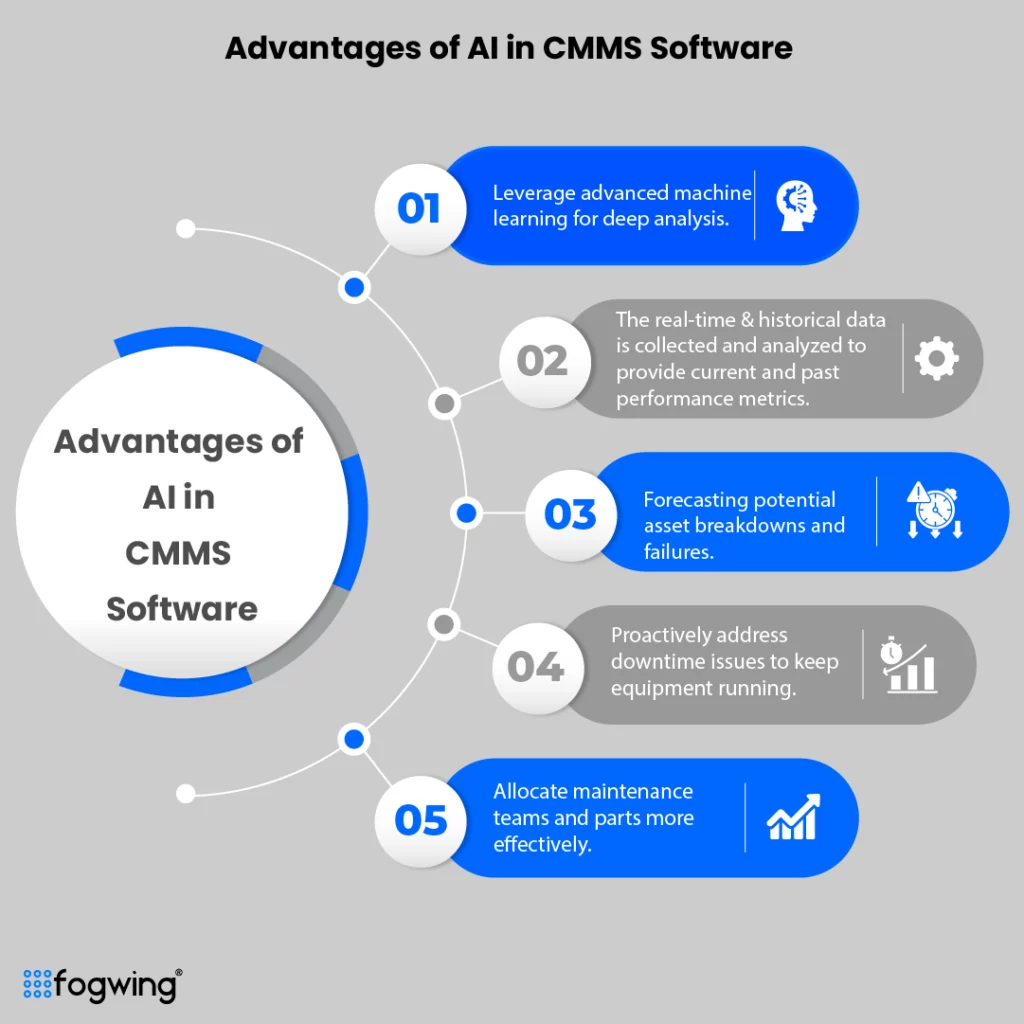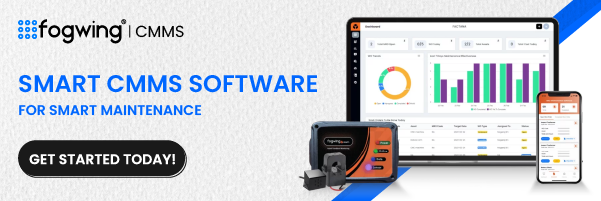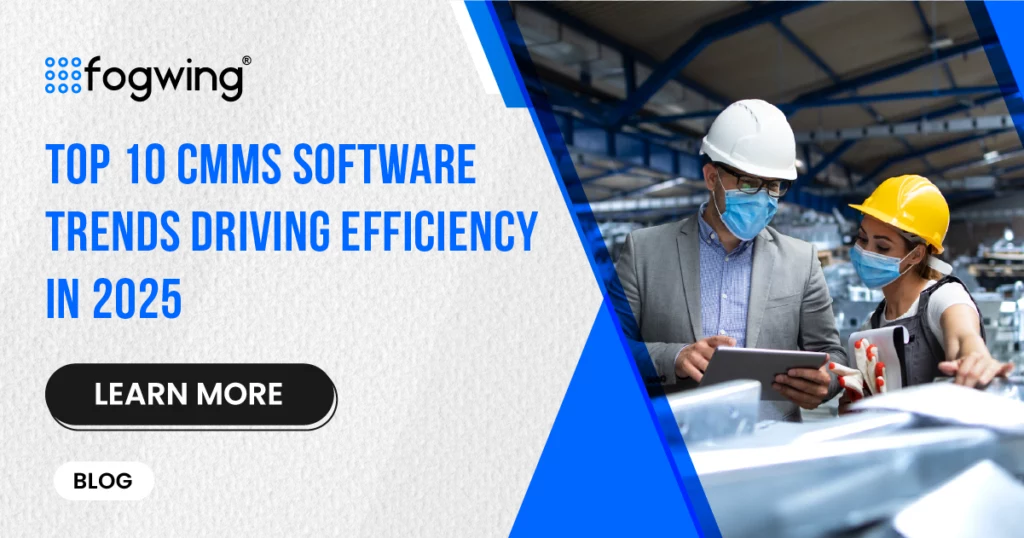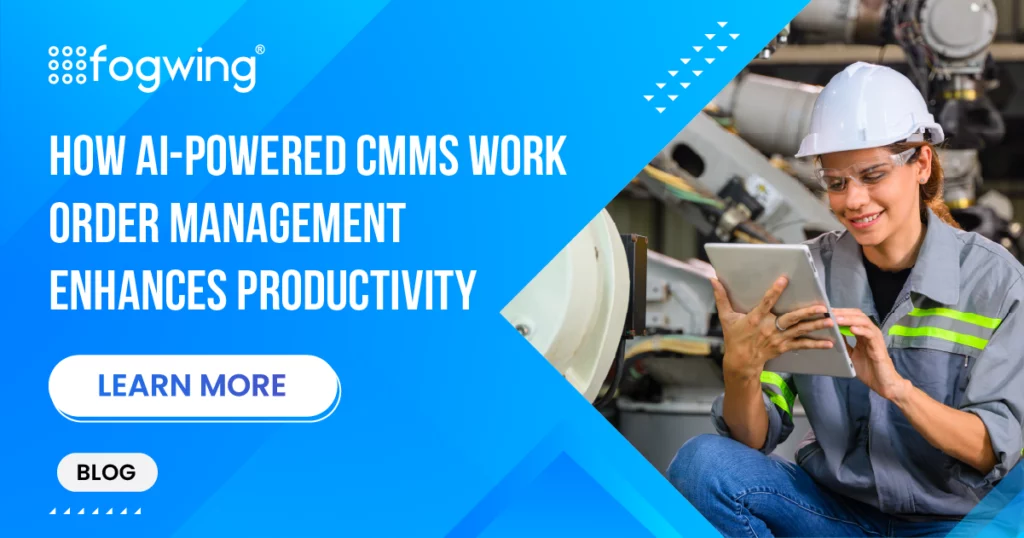In this dynamic world of asset management, maintenance is no longer just about fixing what’s broken; it’s about ensuring that none of the assets have an unexpected breakdown or downtime, affecting the production process.
CMMS software trends 2025 reflect a shift toward proactive, AI-powered, and cloud-integrated maintenance systems.
With decades of changes and advancements in maintenance management, CMMS software trends are now faster, wiser, and more connected than ever.
If you are still considering CMMS as your digital logbook, then it’s time to reconsider. The future of maintenance software will be the central nervous system of production operations.
With this blog, let’s dive into the key CMMS software trends that revolutionize maintenance management in 2025.
Key CMMS Software Trends Driving Efficiency in 2025
- The Evolving Landscape: CMMS is shifting from reactive to proactive strategies using AI, predictive analytics, and digital twins to boost efficiency and resilience.
- Cloud-Based CMMS: Cloud-native CMMS platforms enable mobile access, real-time collaboration, lower costs, and faster updates with strong cybersecurity.
- AI in CMMS Software: AI-driven CMMS automates maintenance planning, forecasts failures, and improves resource allocation through real-time and historical data analysis.
- Predictive Maintenance 2.0: Predictive Maintenance 2.0 combines IoT, AI, and analytics for deeper insights, enabling proactive interventions before failures occur.
- IoT and Hyperconnectivity: IoT sensors provide real-time data on asset health, driving faster diagnostics and predictive maintenance actions.
- Enhanced User Experience: Modern CMMS offers user-friendly designs, voice assistance, and customization tools for seamless, efficient maintenance management.
- Sustainability and Circular Economy Integration: CMMS helps organizations track energy use and emissions and extend asset life, aligning maintenance with sustainability goals.
- Cybersecurity & Data Integrity: Advanced CMMS platforms ensure robust data protection with encryption, authentication, and blockchain for secure, reliable operations.
- Advanced Inventory and Asset Management: Real-time tracking and intelligent alerts optimize inventory, reduce costs, and extend asset lifecycles.
- Future CMMS: Adapting to Changes: Future-ready CMMS embraces AI, IoT, and cloud technologies to enhance agility, innovation, and competitive advantage.
let’s dive deeper into each one to understand how they are transforming maintenance management and driving efficiency in 2025

1. The Evolving Landscape: The Future of Maintenance Software
With digital transformation, maintenance management is currently experiencing its most significant transformation. The CMMS software trends are now shifting from reactive maintenance to proactive maintenance.
It enables the maintenance team to predict asset downtime and breakdowns, utilizing intelligent predictive maintenance systems. With prior information on maintenance requirements, the cloud-based CMMS can help industries with maintenance management.
The advanced CMMS platform now involves technologies like Agentic AI to manage assets proactively, automate maintenance work orders, and anticipate asset failures without human prompts.
Advanced technology, such as digital twins, is now harnessing the CMMS trends. It enables the maintenance team to create a real-time virtual model of an asset, visualize performance, find anomalies, and plan maintenance.
The evolution is not just about keeping machines running—it’s about unlocking new levels of efficiency, sustainability, and resilience in the Industry 4.0 era. With CMMS software trends projected to reach billions, companies are shifting to data-driven strategies, not guesswork, to guide maintenance actions.
2. Cloud-Based CMMS: Scalability and Accessibility
Utilizing a cloud-based CMMS platform is essential in modern maintenance management due to the large real-time data flow. CMMS software is no longer confined to premises. These systems use cloud-native architectures that leverage microservices for enhanced scalability, uptime, and flexibility.
Advantages of Cloud-based CMMS:
- Mobile-first design enables access to systems from any device.
- Real-time collaboration and faster response times for maintenance teams.
- Cloud adoption reduces IT overhead and infrastructure costs.
- Cloud-based systems improve update frequency and deployment speed.
These features empower maintenance teams to work smarter, faster, and cost-effectively.
With cybersecurity mesh architectures embedded in modern cloud solutions, sensitive maintenance and asset data remain secure, making cloud-based CMMS the go-to option for agile, future-ready operations.
3. AI in CMMS Software: Predictive Power and Automation
With the massive advancement in the CMMS software trends, technologies like AI, IIoT, ML, digital twin, and many more advanced technologies are now interrelating with CMMS.
AI in CMMS software is reshaping the future of maintenance software by transforming how maintenance teams anticipate and respond to issues within assets.

Advantages of AI in CMMS Software:
- Leverage advanced machine learning for deep analysis.
- The real-time & historical data is collected and analyzed to provide current and past performance metrics.
- Forecasting potential asset breakdowns and failures.
- Proactively address downtime issues to keep equipment running.
- Allocate maintenance teams and parts more effectively.
These intelligent systems also automate work order generation and maintenance task scheduling, freeing up human resources for strategic maintenance management planning.
AI solidifies the future of maintenance software by helping organizations maintain the governance framework. It also contributes to operational sustainability while cutting maintenance-related costs.
4. Predictive Maintenance 2.0: Beyond Basic Analytics
Predictive Maintenance 2.0 marks a significant leap in the future of CMMS software trends, moving beyond simple alerts to delivering advanced, data-driven forecasts.
Combining IoT sensor data, environmental variables, and historical equipment performance enables more accurate predictions and timely interventions. Prescriptive maintenance is presented to the audience as a strategy for effective maintenance.
With the explosion of connected devices, the resulting data surge enhances the intelligence of AI in CMMS software, enabling even more intelligent, faster decision-making and minimizing unplanned downtime across operations.
5. IoT and Hyperconnectivity: Real-Time Asset Monitoring
The ongoing digitalization and CMMS trends have integrated IoT and hyperconnectivity within maintenance platforms, reshaping the future of asset maintenance.
Sensors embedded in machines continuously stream real-time data, offering instant visibility into asset health, usage, and anomalies. This constant data flow fuels CMMS software trends, enabling faster diagnostics and automating responses to potential issues.
The interconnected systems and platforms inalienably require the maintenance team to shift from reactive routines to predictive and prescriptive, maximize maintenance, and reduce tenancy costs.
6. Enhanced User Experience: Intuitive interfaces and collaboration
Providing a seamless user experience is no longer an option; it is essential for the adequate future of maintenance software. When designing a modern CMMS platform, it is essential to consider the end-users and provide clean, intuitive interfaces that simplify even complex workflows.
Using AI in CMMS software with advanced features like voice assistance, natural language processing, integrated chats, shared dashboards, and task management tools enables the team to manage asset maintenance efficiently.
It offers personalized views, auto-suggestions, and intelligent alerts based on user behavior and asset conditions. The rise of low-code/no-code platforms empower users to customize their CMMS without developer support, making it easier to adapt systems to specific organizational needs.
These innovations and CMMS software trends turn CMMS platforms into collaborative, user-friendly hubs that drive better decision-making and faster responses.
7. Sustainability and Circular Economy Integration
With digitalization, industries face pressure to diminish their environmental footprint, and one of the most impactful trends in maintenance management today is the shift toward sustainability and circular economy practices.
Cloud-based CMMS platforms offer features beyond traditional asset tracking, enabling organizations to monitor energy consumption, track carbon emissions, and support lifecycle assessments.
Cloud-based architectures further contribute by lowering the need for on-premises infrastructure and reducing energy consumption. Real-time dashboards and reporting support sustainability reporting and compliance.
As businesses embrace green initiatives, integrating sustainability into maintenance via CMMS is no longer optional—it’s strategic. In short, today’s CMMS software trends are not just about keeping machines running; they are also about preserving the planet.
8. Cybersecurity & Data Integrity: Protecting Critical Assets
As maintenance systems become more connected, cybersecurity is essential. One of today’s most critical CMMS trends is ensuring strong data protection across digital operations.
Many platforms also integrate blockchain technology to maintain data integrity, ensuring records can’t be altered or tampered with. Regular security audits, compliance checks, and patch management help reduce vulnerabilities.
CMMS software trends protect operational data and ensure trustworthy decision-making by preventing misinformation. As maintenance continues to evolve in a digital-first world, strong cybersecurity in cloud-based CMMS keeps critical infrastructure secure, resilient, and reliable.
The cloud-based CMMS enables continuous data flows between teams, devices, and systems, making built-in safeguards vital.
Cybersecurity and data integration offer multiple advanced functionalities like:
- Continuous data flows: Seamless information exchange between teams, devices, and systems
- Built-in safeguards: Embedded security measures to protect ongoing operations
- Encryption: Data encrypted both in transit and at rest
- Multi-factor authentication: Additional verification layers for user access
- Role-based access controls: Permission settings tailored to individual roles and responsibilities
9. Advanced Inventory and Asset Management
The advanced CMMS focuses on more innovative inventory and asset management. Modern CMMS trends offer real-time tracking of spare parts and equipment, reducing stockouts, over-ordering, and budget overruns.
Effective monitoring of asset performance, contracts, and maintenance schedules in one place enables organizations to extend asset efficiency. Automated alerts and intelligent reordering streamline inventory control, while detailed asset histories support better lifecycle management.
This shift of CMMS software trends toward data-driven, proactive asset management helps maintenance teams reduce waste, control costs, and make smarter investment decisions, solidifying CMMS as a critical tool in today’s maintenance strategy.
10. Future CMMS: Adapting to Changes:
As we look toward 2025, CMMS trends emphasize adaptability and innovation. The future of maintenance lies in platforms that evolve with technological advancements.
CMMS solutions integrate AI, cloud-based infrastructure, and IoT to deliver more innovative, efficient maintenance operations. Therefore, the industry must stay informed and embrace these changes to gain a competitive edge.
In a fast-changing landscape, the ability to adapt isn’t optional; it’s essential. Adaptation boosts productivity, reduces costs, and improves asset performance. Future-ready CMMS tools will be the cornerstone of resilient and agile maintenance strategies across industries.
Conclusion
As we explore the CMMS software trends, we understand that they are no longer just incremental updates; they represent a fundamental shift in managing maintenance.
From predictive AI and cloud-native platforms to IoT integration and circular economy alignment, today’s CMMS is more intelligent, faster, and more connected than ever.
If you’re ready to move beyond reactive workflows and legacy systems, now’s the time to explore future-ready platforms like Fogwing CMMS.
With features like AI-powered insights, mobile accessibility, real-time IoT integration, and built-in compliance tools, Fogwing offers advanced solutions tailored to modern maintenance needs. Embrace the evolution—because the future of maintenance is already here.
FAQs
1. What is the role of IoT in modern CMMS systems?
The Internet of Things (IoT) significantly enhances Computerized Maintenance Management Systems (CMMS) by enabling real-time monitoring, predictive maintenance, and data-driven decision-making. Here’s how:
- Real-Time Data Collection
- Predictive Maintenance
- Automation & Efficiency
2. How does CMMS support sustainability and circular economy practices?
CMMS supports sustainability by extending asset life, reducing waste, optimizing resource use, and enabling energy-efficient operations. It also aligns with circular economy goals through data-driven maintenance and lifecycle visibility.
3. Is CMMS software secure in 2025?
CMMS software in 2025 is secure, featuring encryption, access control, regular updates, and compliance with standards like ISO 27001. Security also depends on proper user practices, including strong passwords and regular system audits.
4. What are the benefits of using CMMS software in 2025?
Here are the key benefits of using CMMS software in 2025:
- Uses IoT and AI to predict failures before they occur.
- Regular maintenance prevents premature equipment breakdowns.
- Streamlined scheduling and alerts minimize unplanned outages.
- Real-time analytics and reports for smarter planning.
- Access CMMS from any device, anywhere.
- Easy documentation for audits and regulatory standards.
- Preventive tasks reduce emergency repair expenses.
- Tracks spare parts, reducing overstock and shortages.
- Automates work orders and simplifies task management.
- Promotes energy efficiency and waste reduction.
5. What should I look for when choosing a future-ready CMMS in 2025?
Look for a future-ready CMMS with IoT integration, AI-driven insights, mobile access, strong cybersecurity, cloud scalability, predictive maintenance, user-friendly UI, and compliance features to ensure efficiency, adaptability, and long-term value in 2025.





